
Apple's Billion Dollar Patent Bluster
It has been widely reported that Apple secured a patent worth a "billion dollars." According to a patent attorney involved in the issue, Apple will be "after every phone company, film maker, computer maker and video producer to pay royalties on every download of not just music but also movies and videos."
The good news is that all the news reports were based on misleading hyperbole; the sole source of the flurry of articles about the billion dollar patent was a press release issued by the same patent attorney who represented the patent, and stood to gain the most from a wild spin on its actual valuation.
The patent in question was described in such glowing words that it nearly overshadowed the clear intent of the press release, which was really all about the patent attorney, Michael Starkweather. After all, it was given the headline: “Apple Settlement Decision Lands Patent Attorney in Public Spotlight.”

Me Me Me!
After effusively describing the absolutely tremendous value of the patent, the press release immediately recommended Starkweather as someone available to "valuate" the patent portfolios other companies might hold.
Rather strikingly, the press release made only a passing mention of the patent's inventor, which it left unnamed, and only referred to Apple and the iPod as benefactors of the "valuating" service Starkweather provides. It spent three paragraphs on his illustrious career; apparently, he’s the most important patent clerk since Albert Einstein.
If Apple, as a publicly traded company, secured a patent worth a billion dollars, why didn't it notify its investors? Apple makes little public mention of its patents. That modest secrecy is exploited by reporters who dig through patent applications related to the company, hoping to find nuggets that might shed light on its future products.
Unfortunately, these patent reports are rarely very useful in proving clear clues to Apple's next batch of products, because patent applications are purposely written to be as broad and generalized as possible. Applications are also published 18 months after they are filed, making any news in them rather stale.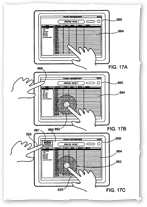

What is a patent, how do patents affect products, why are they so contentious, and how will Apple use this new patent? Here’s a look at some answers.
The Purpose of Patents
The Latin root of patent literally means "to lay open." Patented inventions are "laid open" for society's benefit, and in exchange, inventors are given limited rights to benefit from their development work.
Inventors file an application that describes their invented device, method, or substance in detail. If they are granted a patent on their invention, they hold the exclusive rights to commercially benefit from it for a specific period of time, usually 20 years.
Since the public benefits tremendously from commercial investment in the invention of new technology, the legal protections of patent law increase the potential for a significant return on those investments, in order to encourage new research and development.
Investment Incentive
Patent law protects ideas the same way property law protects real estate. Who would invest in home improvements if anyone else, at any time, could suddenly assume control of their home? Similarly, how many people would invest their money in developing new technology if there were no potential for payback?
In a world without any patent protection, no pharmaceutical company could afford to spend hundreds of millions of dollars to develop, test, and gain regulatory approval for new drugs, because as soon as it finished, another company could simply copy the end results of its work. Without intellectual property laws, there would be no commercial basis for working to achieve anything.
Patents provide a legal mechanism for funding commercial research that would otherwise have no business model.
Open vs Proprietary
Open source software is an example of non-commercial development work: its free solutions are often voluntarily supported by companies who directly benefit from its contributions.
That works well in some areas, but in others, it can not always effectively compete against research and development directly motivated by the potential for profit.
In our existing world of patent law, open source ideas can also come under threat by moneyed interests who hold patents. The accomplishments of free and open source collaborations often can't afford to license ideas that are patented, or wade through the complicated and expensive legal bureaucracy created to manage patents.
Patented ideas are proprietary by definition: proprietary simply means owned, and patents are granted to an owner. This creates contention and problems in the world of open source development, where the ownership of ideas is intentionally shared using licenses such as the GPL, which are designed to prevent exclusive control.
Open source projects aren't the only casualties of patent warfare. Whenever a patent portfolio falls into the hands of attorneys hoping to fully exploit its potential value, the interests of both businesses and consumers are threatened.
Patently Absurd
Any system involving profits will be routinely exploited. Until recent changes were made, US patent law granted inventors exclusive rights for 17 years after the patent was granted. This allowed inventors to file a patent, then continuously delay the final granting date in secret until the invented idea was in widespread use.
Then, to the surprise of the business community, the patent would be granted, allowing the inventor to demand high royalty payments for already established technologies over the next 17 years. The entire premise of a patent--to be laid out in the open--was perverted by this secret attack abuse, referred to as a submarine patent.
Inventor Jerome H. Lemelson was granted over 600 patents, including several that were issued after he died in 1997. Among them were machine vision patents originated decades before industry began using bar code scanners.
After the secretly held patents were granted, businesses that had developed their own technologies were hamstrung by the surfacing submarine patents and demands for royalties.
After Lemelson's death, his estate used these patents to demand ongoing payments until 2004, when 76 of the patent claims related to machine vision were finally determined to be unenforceable. That happened only after millions were spent in court costs to defend against the royalty claims.
Another famous stealth patent case involved the GIF graphics format, which was introduced in 1987. By the early 90's, it was in wide used as a common file format on the web. In 1994, Unisys discovered that it held a patent covering the LZW file compression used by GIF; the format's creators were unaware that any part of GIF was covered by patented ideas. 

Unisys began demanding royalty payments from any company producing software able to generate GIF files. That prompted the creation of PNG as a replacement graphics format, along with a campaign to rid the world of GIFs, but most companies had little choice in the matter. The Unisys patents finally expired in 2004.
Patent vs. Copyright
While original inventions can be patented, creative or intellectual works are similarly protected by copyright. Rather than protect ideas, copyright protects a specific expression of an idea. In the US, exclusive rights to reproduce an article or song are automatically granted to its originator, but the basic ideas they express are not.
In 1985, Digital Research released GEM, a graphical environment for DOS that appeared to be a direct copy of Apple's Macintosh. After Apple sued over copyright violations, Digital Research agreed to change a number of elements for GEM/2.
In particular, GEM/2 stopped using a desktop background with icons or any resizable windows. Those changes largely destroyed the software as a product.

Apple CEO John Sculley also threatened Microsoft with legal action in 1985 after the company demonstrated the original Windows 1.0 for the PC.
Since Microsoft, as one of the first Mac developers, had received early prototype Mac units for software development under non disclosure agreements, Sculley felt Microsoft had violated its agreement with Apple by incorporating many features of the Mac in its rival PC product.
In response, Microsoft's Bill Gates threatened to stop development of Mac products; the dispute was settled in a 1985 contract that granted Microsoft rights to Apple's "visual displays" in exchange for two years of exclusively releasing Excel on the Mac as well as other continued Mac development.
That agreement ended up gutting Apple's case for copyright infringement. Microsoft Windows 2.0, released in 1987, and 1990’s Windows 3.0 incorporated more and more of the Mac's unique features. By the early 90s, Windows was beginning to look a lot like Apple’s 1984 Macintosh and its 1983 Lisa.
Apple filed a copyright violation suit against Microsoft and HP in 1988, listing nearly 200 graphic elements that it claimed were lifted from the Macintosh for use in Windows 2.0 and HP's NewWave software, which ran on top of Windows.
In 1992, the court ruled that most of the copyright claims were already covered under the 1985 agreement, and the remainder were ideas not protected by copyright. Apple appealed, and a higher court affirmed those findings in 1994. Apple then filed for an appeal with the Supreme Court, but that court refused to revisit the case.
Problems with Litigation
The "look and feel" case served to distract Apple from continued innovation, while also forcing Microsoft to deliver software that was different enough from the Mac to make cross platform use of the two systems awkward.
Further, the earlier GEM lawsuit only served to weed out competition to Windows on the PC, leaving Apple with one strong competitor rather than a fractured set of also-rans.
Had Apple applied for patents covering its graphical desktop inventions, the results may have been very different. Another alternative path Apple could have taken would have been to license its interface ideas to competitors, promoting interoperability and consistency.
Both Microsoft and Apple had already paid to license user interface ideas from Xerox, and Microsoft had also attempted to license the Mac interface for use on the PC. By litigating rather than licensing, Apple not only lost time and effort, but also potential royalties, market leadership, and industry compatibility.
Patent Wars
After Apple's failure to protect its software technology using copyright law, the industry increasingly turned to patents, both as offensive and defensive weapons in litigation.
During 1985, there were less than 2,000 computer related patents granted in the US. Today there are well over 150,000 in effect, and every year over 17,000 more are granted in the US alone. That’s a dangerous minefield for companies working to deliver new products.
For large companies with huge patent portfolios, cross licensing allows for a Cold War peace; mutually assured destruction through ongoing, costly litigation is held in check by the threat of the devastating firepower of massive patent arsenals.
The ongoing dispute between Apple and Microsoft was finally resolved in 1997 under a cross licensing agreement. Unfortunately, there is still a clear and present danger from rogue attorney cells that can launch surprise patent attacks.
Patents Against Open Source
In such attacks, the most vulnerable are the unarmed: open source developers who don't even like the idea of software patents. Patent terror attacks on collaborative resources that benefit society present a major problem.
Companies that support open source development have begun building their own patent portfolios as a defense. Red Hat has 6 patents and 13 more pending. Major patent holders including Novell, IBM, and others have committed their own legal efforts to defend open source projects from patent attack.
For companies that use open source software, the possibility of patented technology being laced into open source code is a problem. While companies can effectively hide patent infringements within closed source, anyone can review open source code and then attack companies that make use of it with patent litigation.
SCO’s Shock and Awe Attack on Linux
While Microsoft has announced attempts to cross license technology with Linux developers Novell and Red Hat, it has also supported SCO in its efforts to attack the legal legitimacy of Linux code. 

Without the support of IBM's legal force, Linux developers would have little recourse to defend against attacks from SCO attorneys armed with generalized legal threats of copyright violations.
SCO provides a warning example of the danger of patent warfare. It was able to generate significant fear, uncertainty, and doubt about Linux despite the fact that it didn't even have any patents! SCO even avoided direct copyright claims, basing its lawsuit against IBM on the generalized idea of “trade secrets.”
If a company can mount years of brutal and expensive legal attacks without any patents or even substantial copyright claims, consider the damage possible by litigious attorneys who discover a real and relevant patent!
Apple's Patent Defense
Just like IBM, Apple has to file hundreds of patents annually just to remain competitive and protect its ability to do business in a highly litigious world where trivial ideas can be encumbered by ridiculous patents.
When Apple was sued this spring by Creative over accusations of patent infringement related to the iPod, it responded by countersuing Creative for infringement of its own patents.
The lawsuits were resolved in a $100 million settlement that cost Apple much less than an extended trial and made the companies partners in building iPod peripherals.
Faced with its recent $12.7 million loss, Creative viewed litigating for Apple's iPod revenues as its best bet; without its own patent arsenal, Apple would have faced a possible injunction stopping its entire iPod business, a long and expensive legal war, and a possible judgement giving Creative a significant portion of its iPod earnings.
All of that for a meaninglessly broad patent describing the basic idea of items placed in menus, a far simpler idea than those behind Apple's "look and feel" lawsuit against Microsoft Windows more than a decade ago.
Gimme Gimme
Apple's settlement stipulated that if Creative entered into licensing agreements with other music player manufacturers, it would pay portions of those royalties back to Apple. However, Apple can't make similar deals with other inventors who have less to offer.
Two recent examples of patent attacks on Apple's iTunes, from Hong Kong patent litigator Pat-rights, and Contois Music & Technology, seek patent infraction payoffs that are more difficult to solve in a mutually beneficial way. Contois is the source of the supposed billion dollar patent mentioned above; Apple's solution was to simply buy it for an undisclosed amount.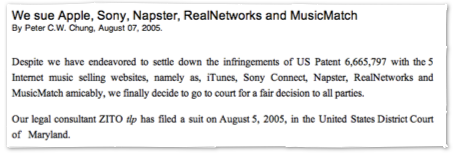

In addition to Pat-rights, another litigious patent company, Burst.com, is suing Apple over patents related to QuickTime streaming.
Burst.com also sued Microsoft, which last year paid for a $60 million license to end the suit. Apple claims the patents are invalid.
Apple's Patent History
Apple, like most successful companies, prefers to focus its efforts on selling products, not the uncertain profits of ongoing litigation. It is primarily entities that have no ability to compete in the marketplace that are willing to gamble on big payoffs from patent suits.
The above mentioned Pat-rights, for example, hoped to take 12% of Apple's revenues related to iTunes and the iPod, plus licensing fees, based on their sketchy "invention" of verifying a machine over a network for DRM. Its attorneys also filed for an injunction against further distribution of the free iTunes.
Rather than attempting to highjack or shut down competitors, Apple has worked to turn its extensive patent portfolio into retail products or standards that can be licensed to other companies.
That's not always easy. When it tried to charge a $1 licensing fee for FireWire, Sony and other patent holders pushed for theoretical fees that priced it out of the market. It also induced Intel to counter FireWire with a new, competing version of USB.
Apple decided to spin FireWire off as an open standard to a group which licensed the technology for a quarter, but USB 2.0 has since become ubiquitous for low end peripherals, marginalizing Apple’s technically superior and faster FireWire standard. 

Given Apple's history of defensive patent use, Starkweather's claim that Apple will spend its resources suing everyone over media downloads is a poorly supported idea.
Of course, given the abject failure of everyone else attempting to run an online music or media store, there's really nobody to sue anyway.
It appears that the patent attorney was just tooting his horn to drum up more work in the patent assault business. Press releases tend to do that.
This Series










Monday, December 4, 2006


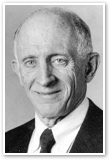
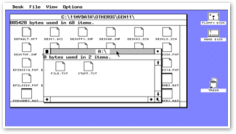
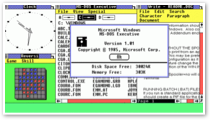
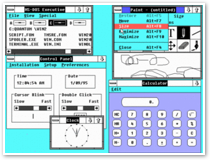
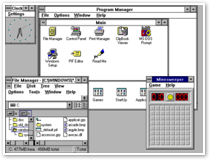
 Bookmark on Del.icio.us
Bookmark on Del.icio.us Discuss on Reddit
Discuss on Reddit Critically review on NewsTrust
Critically review on NewsTrust Forward to Friends
Forward to Friends
 Get RSS Feed
Get RSS Feed Download RSS Widget
Download RSS Widget









